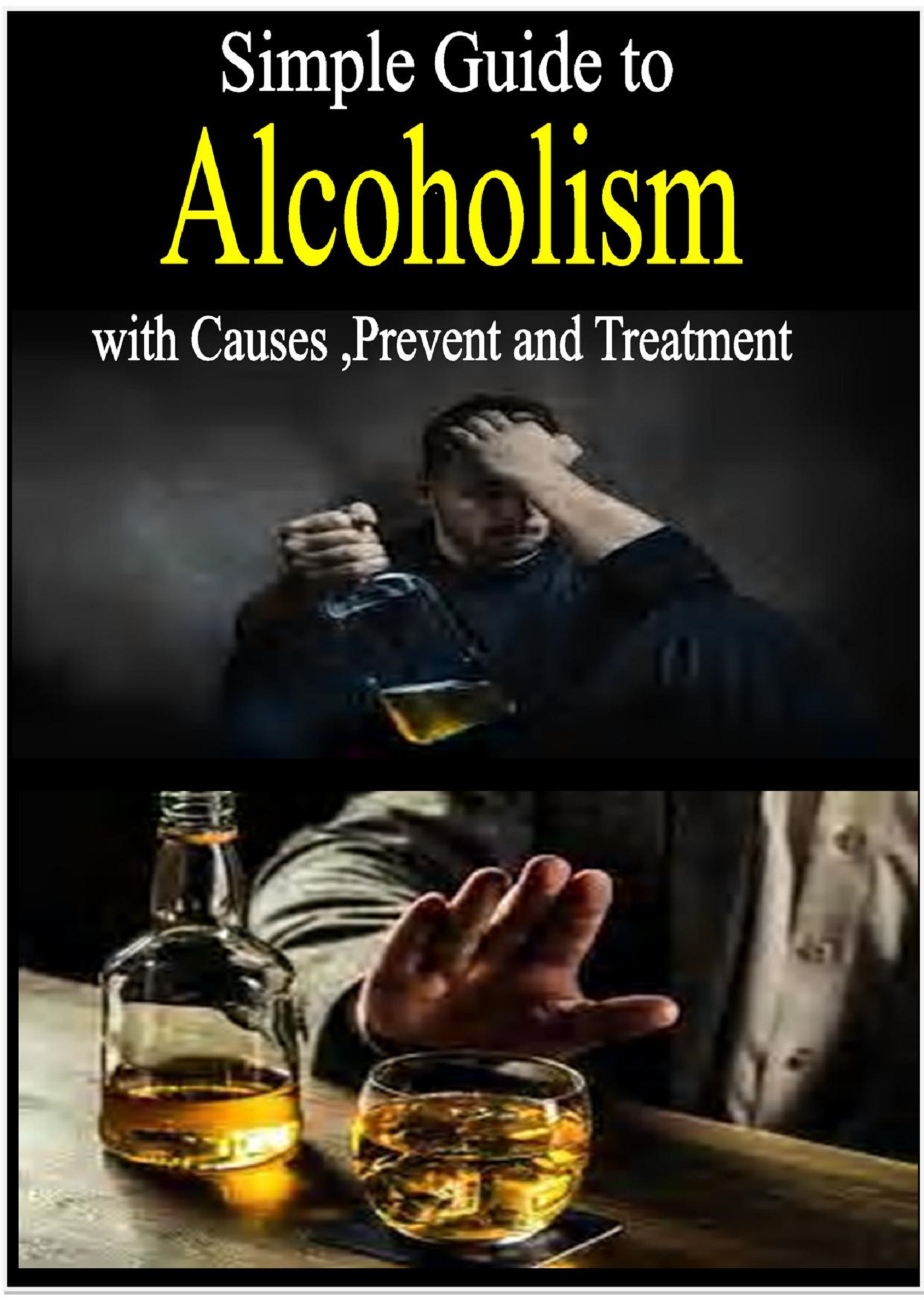
Simple Guide To Alcoholism With Causes , Prevent & Treatment
On Sale
$3.00
$3.00
The reason for Alcohol addiction isn't settled. There is developing proof for hereditary and biologic inclinations for this infection. In the first place degree relatives of people with Alcohol utilize clutter are four to seven times more prone to create Alcoholism than the overall public. Research has ensnared a quality (D2 dopamine receptor quality) that, when acquired in a particular frame, may build a man's shot of creating Alcohol abuse.
For the most part, an assortment of variables adds to the improvement of an issue with Alcohol. Social factors, for example, the impact of family, companions, and society, and the accessibility of Alcohol, and mental factors, for example, hoisted levels of pressure, insufficient ways of dealing with stress, and support of Alcohol use from different consumers can add to Alcohol addiction. Likewise, the variables adding to introductory Alcohol utilize may shift from those looking after it, once the illness creates.
While it may not be causative, twice the same number of men is Alcohol subordinate. One investigation indicated 33% of men age 18-24 met the criteria for Alcohol reliance, and the individuals who begin drinking before age 15 are four times more prone to create Alcohol reliance. Men will probably take part in hitting the bottle hard or substantial drinking. They are likewise more prone to be associated with practices that damage themselves or others, for example, Alcohol related savagery, utilizing different medications, for example, cannabis and cocaine, having intercourse with at least six accomplices, and acquiring for the most part Ds and Fs in school grades.
Alcohol issues shift in seriousness from mellow to hazardous and influence the individual, the individual's family, and society in various unfriendly ways. About 17 million grown-ups in the U.S. are reliant on Alcohol or have other Alcohol related issues, and around 88,000 individuals bite the dust from preventable Alcohol related causes.
In young people, Alcohol is the most generally manhandled tranquilize. Thirty-five percent of youngsters have had no less than one drink by age 15. Despite the fact that it is illicit, around 8.7 million individuals 12 to 20 years old have had a savour the previous month, and this age gather represented 11% of all Alcohol devoured in the U.S. Among underage youth, Alcohol is in charge of around 189,000 crisis room visits and 4,300 passing’s every year.
Withdrawal, for those physically subject to Alcohol, is considerably more unsafe than withdrawal from heroin or other opiate drugs. Alcohol mishandles and Alcohol reliance is currently gathered together under the conclusion of Alcohol utilizes clutter.
What was once in the past called Alcohol manhandles alludes to extreme or risky use with at least one of the accompanying:
Failure to satisfy significant commitments at work, school, or home
Recurrent use in circumstances where it is perilous, (for example, driving an auto or working hardware)
Legal issues
Continued utilization of Alcohol regardless of having medicinal, social, family, or relational issues caused by or intensified by drinking
Despite negative results coming about because of drinking, the alcoholic keeps on drinking to attempt to accomplish the sentiment of happiness they initially experienced when they began drinking.
Previously called Alcohol reliance, this part of Alcohol utilize scatter alludes to a more genuine sort of Alcohol utilize clutter and includes over the top or maladaptive utilize prompting at least three of the accompanying:
Tolerance (requirement for additional to accomplish the coveted impact, or accomplishing the impact with more noteworthy measures of Alcohol)
Withdrawal indications following a diminishment or end of drinking, (for example, sweating, fast heartbeat, tremors, sleep deprivation, sickness, spewing, mind flights, fomentation, discombobulating, shaking, nervousness, or seizures) or utilizing Alcohol to maintain a strategic distance from withdrawal side effects (for instance, early morning drinking or drinking for the duration of the day)
Drinking more Alcohol or drinking over a more extended timeframe than planned (loss of control)
Inability to chop down or stop
Spending a lot of time drinking or recouping from its belongings
Giving up critical social, word related, or recreational exercises in support or utilizing Alcohol
Continuing to drink in spite of knowing Alcohol utilize has caused or compounded issues
Hard-core boozing (devouring a few beverages over a brief timeframe) can happen at any level of Alcohol utilize clutter.
For the most part, an assortment of variables adds to the improvement of an issue with Alcohol. Social factors, for example, the impact of family, companions, and society, and the accessibility of Alcohol, and mental factors, for example, hoisted levels of pressure, insufficient ways of dealing with stress, and support of Alcohol use from different consumers can add to Alcohol addiction. Likewise, the variables adding to introductory Alcohol utilize may shift from those looking after it, once the illness creates.
While it may not be causative, twice the same number of men is Alcohol subordinate. One investigation indicated 33% of men age 18-24 met the criteria for Alcohol reliance, and the individuals who begin drinking before age 15 are four times more prone to create Alcohol reliance. Men will probably take part in hitting the bottle hard or substantial drinking. They are likewise more prone to be associated with practices that damage themselves or others, for example, Alcohol related savagery, utilizing different medications, for example, cannabis and cocaine, having intercourse with at least six accomplices, and acquiring for the most part Ds and Fs in school grades.
Alcohol issues shift in seriousness from mellow to hazardous and influence the individual, the individual's family, and society in various unfriendly ways. About 17 million grown-ups in the U.S. are reliant on Alcohol or have other Alcohol related issues, and around 88,000 individuals bite the dust from preventable Alcohol related causes.
In young people, Alcohol is the most generally manhandled tranquilize. Thirty-five percent of youngsters have had no less than one drink by age 15. Despite the fact that it is illicit, around 8.7 million individuals 12 to 20 years old have had a savour the previous month, and this age gather represented 11% of all Alcohol devoured in the U.S. Among underage youth, Alcohol is in charge of around 189,000 crisis room visits and 4,300 passing’s every year.
Withdrawal, for those physically subject to Alcohol, is considerably more unsafe than withdrawal from heroin or other opiate drugs. Alcohol mishandles and Alcohol reliance is currently gathered together under the conclusion of Alcohol utilizes clutter.
What was once in the past called Alcohol manhandles alludes to extreme or risky use with at least one of the accompanying:
Failure to satisfy significant commitments at work, school, or home
Recurrent use in circumstances where it is perilous, (for example, driving an auto or working hardware)
Legal issues
Continued utilization of Alcohol regardless of having medicinal, social, family, or relational issues caused by or intensified by drinking
Despite negative results coming about because of drinking, the alcoholic keeps on drinking to attempt to accomplish the sentiment of happiness they initially experienced when they began drinking.
Previously called Alcohol reliance, this part of Alcohol utilize scatter alludes to a more genuine sort of Alcohol utilize clutter and includes over the top or maladaptive utilize prompting at least three of the accompanying:
Tolerance (requirement for additional to accomplish the coveted impact, or accomplishing the impact with more noteworthy measures of Alcohol)
Withdrawal indications following a diminishment or end of drinking, (for example, sweating, fast heartbeat, tremors, sleep deprivation, sickness, spewing, mind flights, fomentation, discombobulating, shaking, nervousness, or seizures) or utilizing Alcohol to maintain a strategic distance from withdrawal side effects (for instance, early morning drinking or drinking for the duration of the day)
Drinking more Alcohol or drinking over a more extended timeframe than planned (loss of control)
Inability to chop down or stop
Spending a lot of time drinking or recouping from its belongings
Giving up critical social, word related, or recreational exercises in support or utilizing Alcohol
Continuing to drink in spite of knowing Alcohol utilize has caused or compounded issues
Hard-core boozing (devouring a few beverages over a brief timeframe) can happen at any level of Alcohol utilize clutter.

